The K2 Black Panther in short

The K2 Black Panther (Korean: K2 흑표, Heukpyo) is South Korea’s next-generation main battle tank (MBT), developed by Hyundai Rotem for the Republic of Korea Army (ROKA). It’s one of the most advanced tanks in the world, designed to replace older K1 and M48 Patton tanks. Development started in the 1990s, but it officially entered service in 2014, manufactured by Hyundai Rotem. It had a crew of three thanks to an autoloader system while weighting "only" 55 tons and powered by a German licenced MTU 1,500 hp diesel enginef for runs above 70 km/h on road and 50 km/h off-road thans to an hydropneumatic suspension allowing it to “kneel,” “lean,” or “rise” for better hull-down positioning, firing angles, or concealment.
Its 120 mm L/55 smoothbore gun was comparable to the Leopard 2A6, able to fire all standard NATO rounds and advanced KSTAM (Korean Smart Top-Attack Munition), the latter enabling a a fire-and-forget projectile that can hit enemy tanks from above. Its protection relies on Composite armor + ERA (Explosive Reactive Armor) with an Active Protection Systems (APS) Soft-kill system to jam incoming missiles; development ongoing for hard-kill interception, NBC protection and its modern fire-control system was designed to track low-flying helicopters, moving targets, and engage while on the move whereas its digital battlefield integration enabled Network-capable for modern combined arms operations.
Currently in service with the ROKA, the ROTEM signed a major deal in 2022 with Poland to acquire and co-produce K2PL, a variant tailored for European needs. There is currently a lot of potential interest from other countries looking interesting for a design with no strings attached politically that can be produced quickly in large numbers and involved local industries with some tech transfer.
South Korea's master ace
The pride of South Korean Army nowadays is the K2 Heukpyo (Black Panther), one of the latest MBTs to date (freshly introduced as of 2014) and certainly on the shortlist of the very best worldwide. Built by Hyundai Rotem at ?7.8 billion (US$8.5 million), this was a far cry from the M48K it replaced or even compared to the K1. In fact, it was planned by the South Korean Agency for Defense Development to get rid of foreign parts as much as possible and also enabling export capabilities (without third-party licensing problems).Development
Of course, the K1A1 already showed the way and was superior to any North Korean tank at the time. Development started in 1994. Rotem's very first designs in the late 1990s tried an unmanned turret, and the Rheinmetall's experimental 140 mm smoothbore gun was also for a time (until the company reversed t a more conventional 120mm gun) envisioned. With the XK2 program, engineers took a compromise eventually, with a 120 mm/L55 with a reconfigurable cradle able to mount the 140mm if need be.By 2006 already, the K2 production model was ready for testings. Total expenditures for the project arose to US$230 million. Production started in 2007, on March, 2, at Changwon in South Korea. A local powerpack was designed, based on the German MTU-890, 1,500 horsepower strong, but it showed a considerable amount of teething problems that delayed operational service acceptance for two years. There was a new bump in 2011, when the Defense Acquisition Program Administration had to admit that the engine would be replaced by the original MTU-890 instead, at least for the first 100, delaying operational introduction until March 2014.
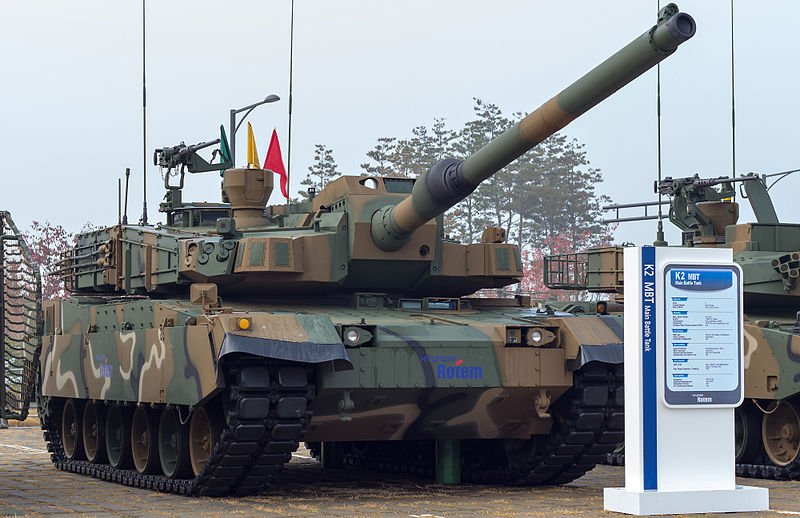
The K2 at ADEX 2013.
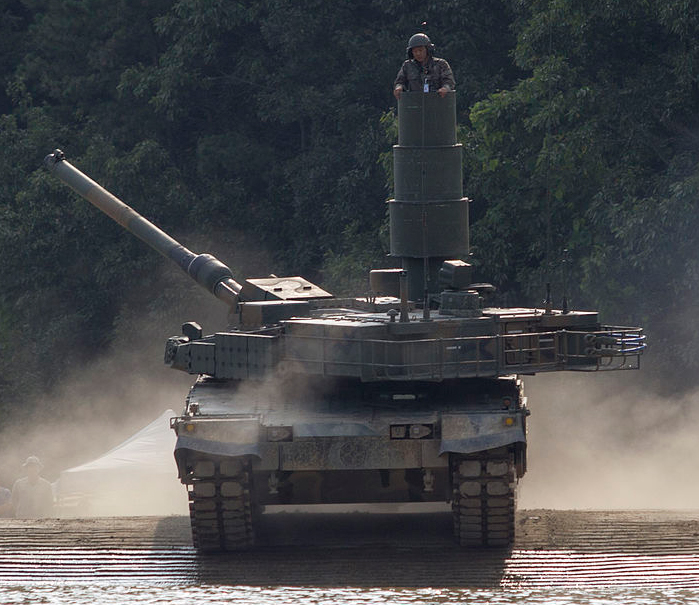
The K2 crossing a trial pool after a preparation, showing its snorkel mast.
Improvement from the K1A1
Both the K2 and K1A1 guns were of the same caliber, but the former displayed a much longer barrel (1.3 m or 4.3 ft) for a greater muzzle velocity of 1400 m/sec in return, enabling much better levels of accuracy and penetration values. In addition mobility was improved as it could ford 4m of water without a short preparation (see later). Posture control function (linked to the hydro-pneumatic suspensions) was also a new feature allowing to raise or lower the tank silhouette, while the laser warning system directly pointed the turret towards the source of illumination, saving precious seconds.K2 price tag question
All in all, it was indeed an impressive new Main Battle Tank, which revealed itself, after all these years of development and teething problems of its ambitious domestic powerpack, also one of the top costiest tank ever, at US$8.8 million apiece. To give a comparison, the Chinese ZTZ-99 is worth $2.6 million, and the Abrams is approximately $8.5 million apiece. The Leclerc seems to still top the list at $12.6 million (even $23 million when accumulating all past developments). The Japanese Type 10 is the second costliest at $9.4 million. It is difficult to estimate the price of the comparable, opposite North Korean Popkung Ho, would be in the range of $2 million. It's quite difficult to assert.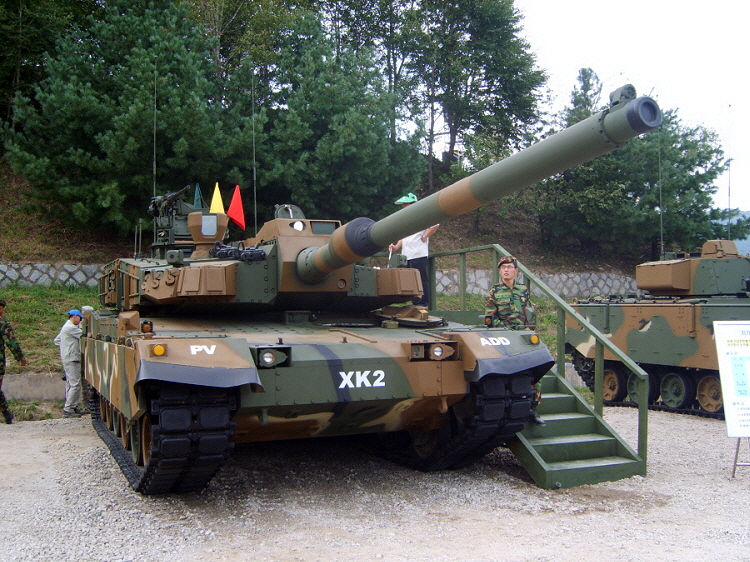
XK2 prototype.
Protection
As most modern MBTs the hull is a multi-layered one, with a welded hardened steel core, covered by modules of composite armour, details of which are of course duly classified. The latter comprises K2 PIP Non-Explosive Reactive Armor and ERA blocks, in particular to the turret's front. Tests showed the frontal armour was impervious to the 120 mm APFSDS round fired from a L55 gun. There is also an active layer with a soft-kill anti-missile system, that would be completed with the K2 PIP by a hard-kill anti-missile defense system that can track and target the incoming missiles.To complete the active protection, a millimeter band radar system is installed, providing Missile Approach Warning System (MAWS). Sensors transmit data in real time to the computer that can triangulate incoming projectiles, and enable automatic release of Visual and Infrared Screening Smoke grenades as well as warning the crew. Of course collective NBC with overpressure is fitted as a standard (completed by atmospheric sensors), as well as automatic fire suppression systems in the crew and engine compartments.
The Korean Active Protection System (KAPS) locally developed is a hard-kill active protection system, using a three-dimensional detection, tracking radar and thermal imager to detect incoming threats. Range is 150 meters around the tank, while a defensive rocket can destroy incoming targets at 10–15 meters away. KAPS deals with rocket-propelled grenades and anti-tank guided missiles (ATGMs). Unit price is ₩670 million ($600,000).
Firepower
The core of the K2 lays into its locally developed Hyundae WIA smoothbore 120mm /55 caliber complemented by an autoloader similar to the one used on the leclerc, reducing the crew and allowing for much greater rate of fire, of 10 round per minute. To serve it there was a 16-shell read-round ammunition magazine, with a total of 40 carried between the hull and turret. Secondary armament comprised a roof-mounted 12.7 mm (0.5 in, cal 50) K-6 heavy machine gun (3,200 rounds) and a 7.62 mm coaxial light machine gun (12,000 rounds).The main ammunitions are the APFSDS (improved tungsten core with a special heat treatment) kinetic energy penetrator, seconded for lightly armoured targets of soft targets by a multi-purpose HEAT chemical energy round (similar to M830A1 HEAT MP-T). Importantly there is also a specially developed Korean Smart Top-Attack Munition (KSTAM), sort of fire-and-forget semi-autonomous ammunition that operates at 2–8 km (1.2–5.0 mi), launched in a mortar-type high trajectory.
Upon arrival to the target, the on-board millimeter band radar is enabled after the opening of a parachute, time for the Infrared and radiometer sensors to seek targets and when spotted, an explosively formed penetrator is launched from a top-down position, perfect to target these generally less well protected parts of the enemy tanks. Choice of the target can also be commanded by the gunner from a remote link.
So serve the armament, the FCS comprises an Extremely High Frequency radar system, coupled with a laser rangefinder and crosswind sensor. The system can track and lock on several targets simultaneously at 9.8 km (6.1 mi) using a thermographic camera. There is a state of the at for the gun stabilizer and trigger-delay mechanism to fire accurately on the move. The trigger-delay system allows the beam to be re-aligned after encountering a very uneven terrain. Also locally designed are the Korean Gunner's Primary Sight (KGPS) and Korean Commander's Panoramic Sight (KCPS).
They are derived from those used in the K1A1 tanks but upgraded. The system allows a hunter-killer mode and tank commander override. Redondant systems, as stated by the manufacturers, should allow in an extreme situation the tank to be manned by the driver only, the gun being able to be automatically pointed and fired through the computer's decisions with data provided by the sensors about the best opportunity targets, in turn.In addition the K2 operates the C4I (Command, Control, Communications, Computers, and Intelligence) system, a battlefield awareness system, with modern touch-screen consoles and digital displays (similar to the US Inter-Vehicular Information System), allowing it to share data with other units, on the ground or the air. There is also GPS (Global Positioning Satellite) navigation uplink. An IFF/SIF (Identification Friend or Foe/Selective Identification Feature) is also part of the package, launching a 38 GHz beam from the mantlet to the targeted vehicle to avoid mis identifications and friendly fires.
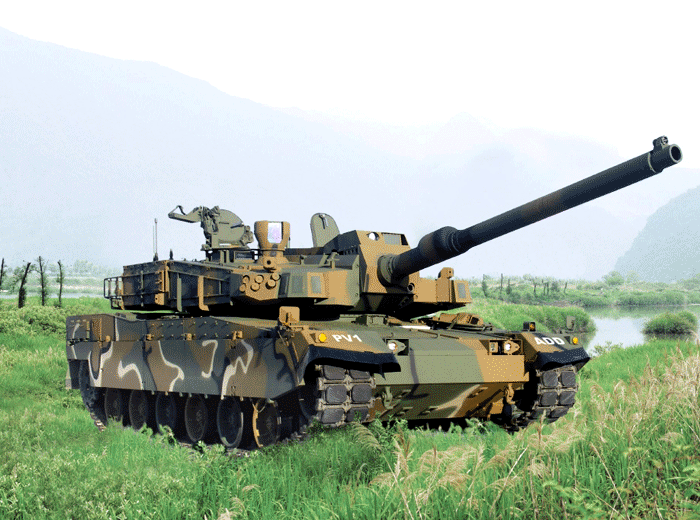
Mobility
Engine
The tight fit of the engine compartment (the main diesel is mounted transversally) allowed to engineers to cram into a Samsung Techwin gas-turbine engine to boost speed for short runs. It develops 100 horsepower (75 kW) and is also used an an auxiliary unit for on-board systems and some defense systems when the main diesel is shut. This turbine also helps for minimal thermal and acoustic signatures, and to save fuel. The power unit is a 4-cycle, 12-cylinder water-cooled diesel which develops 1,500 hp (1,100 kW), originally built by Hyundai (second serie planned in 2014+), whereas the first batch of 100 was powered by the German MTU-80 diesel.Performances
This powerpack gave the Korean MBT a top speed of up to 70 km/h on flat, up to 52 km/h off-road and 0 to 32 km/h acceleration in 8 seconds. As shown in field tests, it was shown could climb 60° slopes, and 1.8 m vertical obstacles. The K2 can ford up to 4.1m of water with a short preparation (20-30 min) a real improvement over the previous two hours or so, and to ford 2 meters deep on the previous K1. The snorkel system doubled as a conning tower for the tank commander. One of the solution was to allow to fill the hull with 500 gallons of water to have a balance pressure and avoid excessive buoyancy from the inside. When resurfacing it was combat-ready.Suspensions
The other major advantage of the K2 over previous designs is its advanced suspensions system called the In-arm Suspension Unit (ISU), which allowed to manage every bogie and its control on the ground. Hydro-pneumatic, it allowed the whole hull to "sit", "stand", "kneel" or "lean" on each side, giving for example the perfect hull-down position when awaiting the enemy, or more elevation (24°) when firing on high-up targets, including low-flying aircraft. When running at high speed, "standing" the suspensions made for a higher ground height, and better mobility by amplitude over rough terrain, as each bogie could be adjusted in real time on the fly to deal with vibrations and cushions the chassis.In service
The K2 entered service in 2013 (early, preserie of 25) and 2014 (official) as stated with a German MTU engine instead of the domestic powerpack for the first batch. As for today (according to Military-Factory), 241 K2s has been delivered by the consortium, including Hyundai ROTEM/Agency Samsung, Doosan, World Industries Ace Corporation. Total planned its about 680 for the late 2020s/early 2030s, including the upgraded variant, the K2 PIP.If so, South Korea would field quite an impressive array of modern tanks to replace its age-old M48/M60K, added to the already existing 1,500 modernized PIP K1 and K1A1 for a grand total of 2180 modern MBTs, to compare for example to 400 Leclercs in service with the French Army. According to 206 were deployed, and 100 more are requested by the Army as of may 2016 to be deployed on the border with North Korea.
K2 PIP
This upgrade is intended for the near future (2016-2020) to improve the early batches. It comprises:-Upgrading of the the Semi-Active hydropneumatic suspension Unit, to an fully Active Unit
-High-resolution, real time terrain-scanning system, to improve the suspensions behaviour on rough terrain, essentially "planning ahead" the nearby terrain up to 50 meters away, calculating the optimal position of the bogie.
-Integration of a hard-kill anti-missile KAPS system.
-Addition of NERA modules (Non-Explosive Reactive Armor).
-Ongoing tests on a 120 mm/L55 electrothermal-chemical gun.
Exports: The Altay
Turkey "adopted" the K2: Indeed after a competition held against the Leclerc and Leopard 2, the K2 won and in June 2007, negotiations ened with an arms deal contract (₩500 billion/US$540 million with Otokar) for licensing the K2 design of in Turkey. On July 30, 2008, a further $540 secured technological transfer and design assistance. The local design is known as the MİTÜP Altay, the first Turkish local MBT, final development phase today. Many alteration has been made to the original design, but its still shares many subsystems with the K2. In 2011 however, the contract coverage was shortened due to development delays and costs. In addition, late September 2013, the Peruvian Army also tested the K2.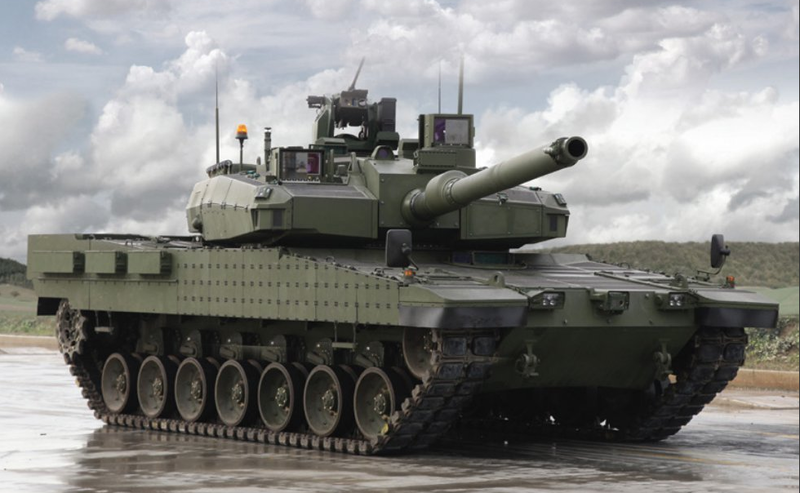
The Altay, intended to enter service in 2018.
Rotem K2 specifications | |
| Dimensions | 10.00 m x 3.17 x 2.20 m (32'81'' x 10'17'' x 7'22'' ft) |
| Total weight, battle ready | 55 tonnes (60 short tons, 121,254 lb) |
| Crew | 3 (driver, gunner, commander) |
| Propulsion | 12-cyl wc MTU MB-883 KA500 diesel, 1,500 hp + turbine |
| Suspension | Hydropneumatic suspensions |
| Speed (road) | 70 km/h (43 mph) |
| Range | 450 km (220 mi) |
| Armament | 120 mm sb main gun, 12.7 mm K6, 7.62 mm LMG |
| Armor | Combination passive/active protection, ERA/NERA, See notes. |
| Total production | 241+ as of 2016 |
The Case of K2GF, the Polish K2
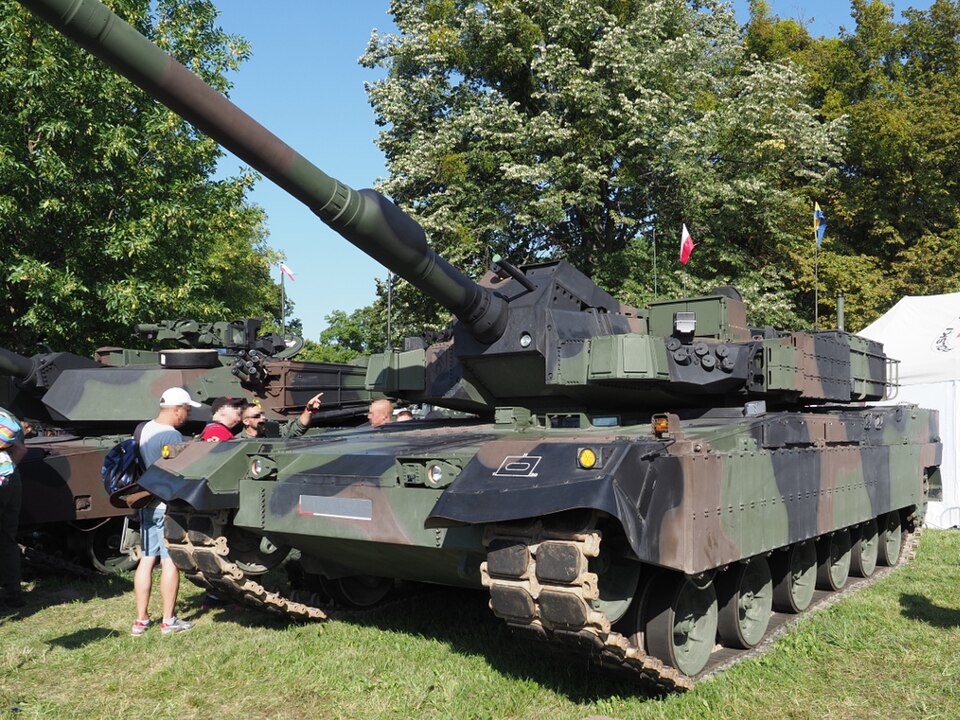
K2 at Radom, Poland (2023)
The K2 Black Panther remained a Korean-only main battle tank until a historical order passed by Poland in 2022. This, contrary to commn belief, did not come from the 2022 invasion of Ukraine, as there had been discussions in Poland from 2014 onwards and the war in Donbass about how to bolster the country's conventional deterrence. Since 2015, the Polish MBT park comprised ageing PT-91 Twardy (a local full upgrade and modernization of the T-72) and 150+ Leopard 2A4, A5. The 2NJ was discussed for a time, but no order for the next 2A6 was secured, probably on price grounds. Since apart Germany and the US no country to provide an additional 250 MBTs planned in 2018, Poland turned overseas.
In January 2020 indeed, Poland announced negotiations with Hyundai Rotem to license produce the K2 Black Panther for the Polish Army. On February 24, Russian invaded Ukraine, which urged the program. On 13 June 2022, the Polish Ministry of Defence announced a memorandum of understanding (MoU) signed for the purchase 180 K2 tanks, all produced by Hyundai Rotem, before the local production of the K2 could be established with South Korean help.
This made waves in Europe, as the most largest MBT program in a decade, Poland knowing full well that no country in Europe proper could deliver the goods in such quantity and under such delays. Britain and French closed their own manufacturing for the Leclerc and Challenger II respectively, limited to upgrade programs, as in the US, which the Abrams is updated and refusbished since a decade. The US also approached Poland for refurbished Abrams M1A3s but this ws kept as an option.
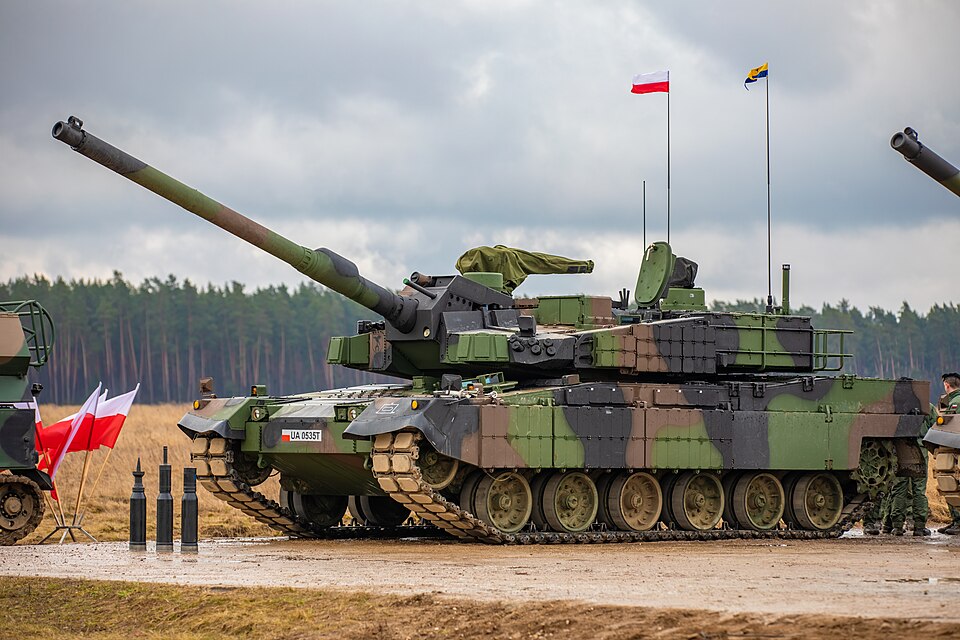
A Polish K2GF tank in 2023
On 27 July 2022, the Polish Armaments Group (PGZ) and Hyundai Rotem signed a framework agreement for 180 K2s plus a production in Poland of no less than 820 K2PLs, the Polis variant. The contract stressed rapid delivery and extensive technology transfer from South Korea. The timetable for the first deliveries of the K2PLs from Poland under license was initially 2026.
On 26 August 2022, the first executive agreement ($3.37 billion) was signed and confirmed the delivery of 180 K2s in a new facility in Morąg, northern Poland, including training programs, logistics packages, ERA packages, and fifty thousands 120 mm shells, four and a third million 7.62 mm and 12.7 mm machine gun ammunition. Soldiers of the 16th Mechanised Division were sent to South Korea in October 2022 to be the first benefiring from the training program. Deliveries of the 180 K2s were scheduled to be stages between 2022 and 2025, to be deployed to the 20th Mechanised Brigade, 15th Mechanised Brigade and 9th Armoured Cavalry Brigade, all belonging to the 16th Mechanised Division.
By 7 September 2022, PGZ and Hyundai Rotem signed a partnership agreement for the domestic K2PF but also new armored vehicles and ground unmanned systems with joint cooperation in building manufacturing facilities in Poland, to not ontly produce but also maintained the 1000 K2s planned (180+820). The agreement planned this would be a hub in Europe for the sale and maintenance of Hyundai Rotem's armoured vehicles at large. On 5 December 2022, the first batch of ten K2s arrived in Poland after six months after signing, showing Hyundai production's velocity, all startung field tests with the 20th Mechanised Brigade of the 16th Mechanised Division on 9 December 2022. On 31 March 2023, the Polish MoD signed an agreement for the K2PL production in Poznań, starting with a batch of K2PL from Korea, redesigned to meet Polish requirements, and as well as the design of a support vehicle (ARV) on the same platform.
If the program goes according to plan in 2030, Poland will have the largest park of MBTs in Europe, by far. It should be added than in between, agreements were also made wth the US for the procurement "off the shelff" of 200 M1A2 Abrams SEPv3 as part of the "Wilk" program planning a total of 400 new tanks. Indeed Poland delivered some 200 T-72s to Ukraine, including of the PT-91 variant which needed replacement. As for the "Korean hub", it goes with the delivery of 460 K9 Thunder, giving Poland the largest park of tracked artillery in Europe as well, also frpm South Korea and also assorted by a plan of domestic production.
Gallery

K2 Black Panther as of today.

Polish K2GF "czarna pantera" (no official name for now) as of 2025.
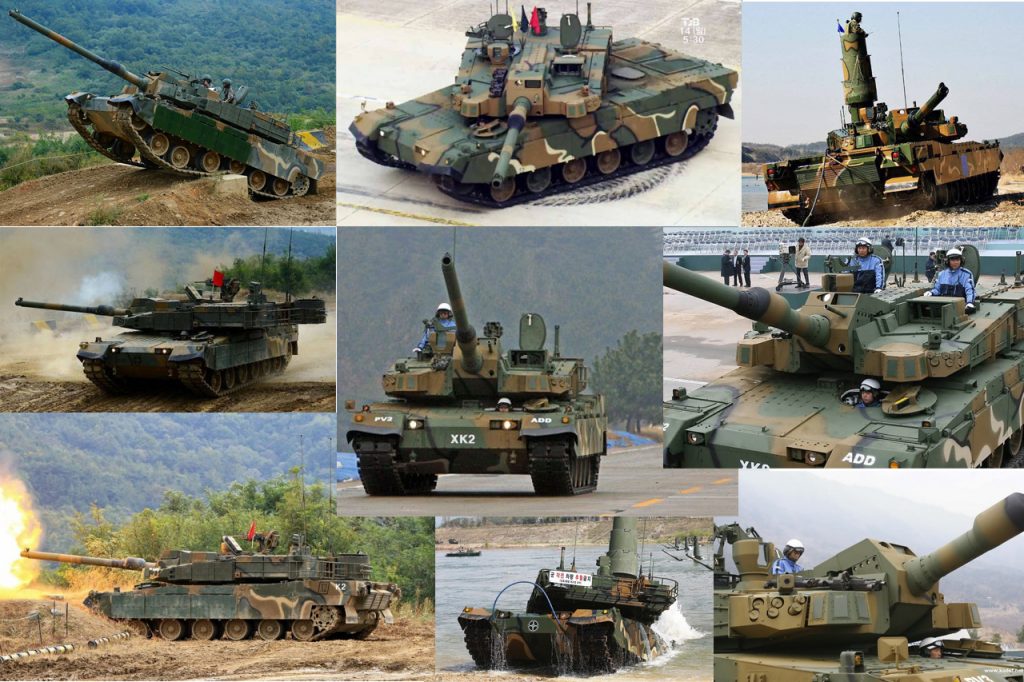
Additional web references of the K2.
More
The K2 on wikipediaOn defense-update
On thaimilitaryandasianregion
Additional planning informations - tanknutdave.com
On army-guide.com
Also crossings with military-today.com, army-technology.com, militaryfactory.com.
Video
Youtube
Modern Tanks
Modern MBTs posters

Denel Bagder (2018)

Type 16 MCV (2016)

Gepard 1A2 last rounds 2011

SANDF

Russian AFVs

Main Battle Tanks
